




Back to the Around WWI calendar



 In January 1916 the government passed the Military Service Act. This said that all single men, aged between 18 and 41, must join the armed forces. This is called conscription. It excluded those who were medically unfit, clergymen, teachers and a few groups of workers in industry. Those men who objected to fighting on moral grounds were also excluded and, in many cases, were given non-fighting jobs at the front. In May 1916 the Act was amended to include married men. Just to get ahead a bit, in 1918 a second act raised the age limit to 51.
In January 1916 the government passed the Military Service Act. This said that all single men, aged between 18 and 41, must join the armed forces. This is called conscription. It excluded those who were medically unfit, clergymen, teachers and a few groups of workers in industry. Those men who objected to fighting on moral grounds were also excluded and, in many cases, were given non-fighting jobs at the front. In May 1916 the Act was amended to include married men. Just to get ahead a bit, in 1918 a second act raised the age limit to 51.
Conscription was not popular and in April 1916 over 200,000 demonstrated against it in Trafalgar Square. Although many men failed to respond to the call-up, in the first year 1.1 million enlisted. During the whole of the war conscription raised some 2.5 million men.
The main reason for the need to conscript people was the horrific number of casualties the British army suffered at the start of the war in particular. In the first year of the war 12,733 men died or were wounded at the Battle of the Marne, 75,000 at Ypres, 205,000 at Gallipoli, 50,000 at Artois and 50,000 at Loos. To save you doing the Maths, that's a total of nearly 400,000 men or over half the original number of soldiers at the start of the war.
At the end of May 1915 there was the only major naval battle of the war. The British had been stopping the German fleet from leaving its home ports and sailing into the Atlantic Ocean, where they could have caused problems for the many merchant ships bringing supplies to Britain. On May 31 1915 the German fleet of 99 ships left port. The British fleet of 151 ships also left their ports in Rosyth, Cromarty and Scapa Flow. The British had two main fleets, one commanded by Vice Admiral Sir David Beatty and the Grand Fleet commanded by Admiral Jellicoe.
Beatty was first to sight the Germans and he cunningly manoeuvred them north toward Jellicoe's ships. The two fleets opened fire at a distance of about ten miles. The Battle went on for a couple of days and at the end the British had lost 14 ships and over 6,000 men while the Germans lost 11 ships and over 2,500 men. Both sides claimed a victory. Germany because they had sunk more British ships and Britain because, after this battle, the German navy didn't really try to head into the Atlantic again.

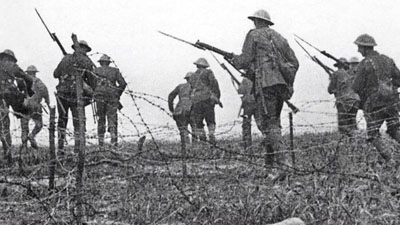 Meanwhile, back on land, a new battle began that would last for almost five months. It was known as the Battle of the Somme, it was fought in northern France and was one of the bloodiest battles of World War One. I'm not going to give you a day-by-day account but to give you an idea I will tell you what happened on the first day of the battle, July 1 1916. It was fairly typical of how the war was fought.
Meanwhile, back on land, a new battle began that would last for almost five months. It was known as the Battle of the Somme, it was fought in northern France and was one of the bloodiest battles of World War One. I'm not going to give you a day-by-day account but to give you an idea I will tell you what happened on the first day of the battle, July 1 1916. It was fairly typical of how the war was fought.
First the Allies bombarded German trenches for seven days and then sent 100,000 men over the top to attack the German lines. Sadly the bombardment had not had the desired effect of killing Germans and destroying their guns. They had been waiting in their trenches. As the British soldiers advanced, they were mown down by machine gun and rifle fire. In total, 19,240 British soldiers lost their lives on this one day. It was the biggest loss of life on any one day in the history of the British army. However, in spite of these heavy losses, Douglas Haig, the British general, agreed to continue the attacks.
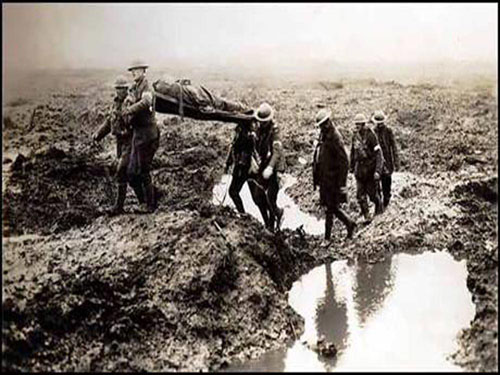 Battles continued until, with winter approaching, the fighting was suspended on November 19 1916, with General Haig vowing to continue in February 1917. In 141 days the British had advanced just seven miles and failed to break the German defence. Some historians believe that with a few more weeks of favourable weather the Allies could have broken through German lines. Others argue the Allies never stood a chance. In any case, the British army had inflicted heavy losses on the German Army and in March 1917, the Germans made a strategic retreat to the Hindenburg line rather than face the resumption of the Battle of the Somme. In total, there were over one million dead and wounded on all sides during the five months.
Battles continued until, with winter approaching, the fighting was suspended on November 19 1916, with General Haig vowing to continue in February 1917. In 141 days the British had advanced just seven miles and failed to break the German defence. Some historians believe that with a few more weeks of favourable weather the Allies could have broken through German lines. Others argue the Allies never stood a chance. In any case, the British army had inflicted heavy losses on the German Army and in March 1917, the Germans made a strategic retreat to the Hindenburg line rather than face the resumption of the Battle of the Somme. In total, there were over one million dead and wounded on all sides during the five months.
There was also now a new injury to deal with for those doctors and nurses on the front; shell shock. This was a term used by an English doctor, Charles Myers, to explain the medical condition many soldiers began suffering from in WWI. Today we call it PTSD or post traumatic stress disorder and it can affect anyone who has been through a horrific experience, more than likely for a continuous period.
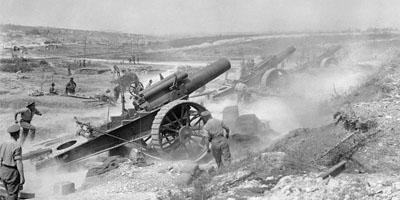 The symptoms were varied but could include tiredness, not being able to sleep, shaking, confusion, nightmares and some loss of sight and hearing. At first shell shock was thought to be caused by soldiers being exposed to exploding shells but soon doctors realised it was something else as it affected men who hadn't even been to the front. By 1916, over 40% of the casualties in fighting zones were victims of the condition. Many of the shell shock victims had served at the Battle of the Somme - official figures put the figure at 16,000 but military experts say that the true figure could be much higher.
The symptoms were varied but could include tiredness, not being able to sleep, shaking, confusion, nightmares and some loss of sight and hearing. At first shell shock was thought to be caused by soldiers being exposed to exploding shells but soon doctors realised it was something else as it affected men who hadn't even been to the front. By 1916, over 40% of the casualties in fighting zones were victims of the condition. Many of the shell shock victims had served at the Battle of the Somme - official figures put the figure at 16,000 but military experts say that the true figure could be much higher.
At the time there was very little sympathy for the suffers. It was seen as a weakness or the signs of a coward. Some soldiers ran away and deserted. If found they could then be shot. Those that didn't run experienced some really harsh treatment like being locked away on their own. At the end of the war over 80,000 cases of shell shock had been diagnosed and many men continued to suffer, some for the rest of their lives.
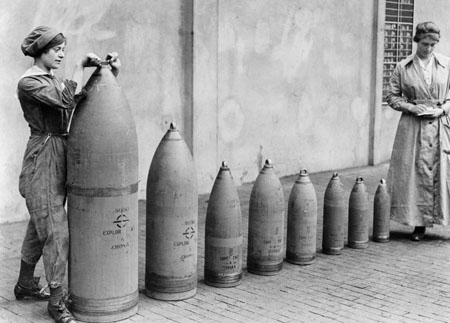 Women suffered too but in a different way though no less cruel. The high demand for weapons resulted in the munitions factories, places where the shells fired by the new big guns were made, becoming the largest single employer of women during the war. Munitions work was well paid if you had been used to getting paid as a servant. However the work was for long hours and really dangerous. The women worked with something called TNT which is a poisonous explosive. Many women developed a condition called toxic jaundice which made their skin turn yellow. This led to the women working in these factories being known as “canaries”. About 400 women died from being exposed to TNT during WWI.
Women suffered too but in a different way though no less cruel. The high demand for weapons resulted in the munitions factories, places where the shells fired by the new big guns were made, becoming the largest single employer of women during the war. Munitions work was well paid if you had been used to getting paid as a servant. However the work was for long hours and really dangerous. The women worked with something called TNT which is a poisonous explosive. Many women developed a condition called toxic jaundice which made their skin turn yellow. This led to the women working in these factories being known as “canaries”. About 400 women died from being exposed to TNT during WWI.
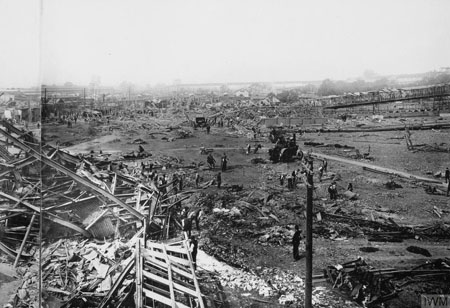 There were also several devastating explosions in which women workers were killed. The aftermath of one of the worst, at Chilwell, Nottinghamshire is shown in this photograph.
There were also several devastating explosions in which women workers were killed. The aftermath of one of the worst, at Chilwell, Nottinghamshire is shown in this photograph.
Slightly more pleasantly women also got work as railway guards and ticket collectors, bus and tram conductors, postal workers, police, firefighters and in banks. Women would also work on the farms helping to produce the food which was so needed. The role these women played was crucial not only to the war effort but also to the running of the country. Even during the worst of the war, the buses still ran and the mail was delivered.
Going forward a little, 9% of all British men under 45 died during WWI. This left many women unable to find a husband once the war ended. While many middle class women did remain unmarried due to the lack of available men in the relatively narrow social sphere in which they moved, some women choose to remain single, partly for financial reasons. Women could become teachers or nurses but, as I understand it, not if they were married. I certainly know this to be true before the war because my paternal grandmother, paternal means on my father's side of the family, was a teacher until she married in 1905 when she had to resign.
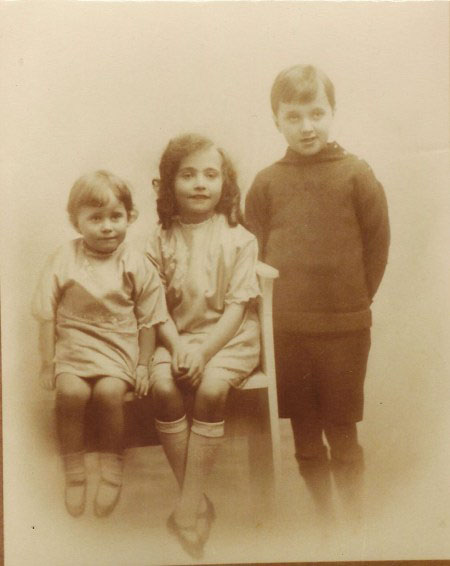 Staying with family to finish this section, you know how I have said that history is not just Kings and Queens, battles and wars but can be more personal, your own history, so, right in the middle of WWI, well a day before the actual middle, who should arrive but..........my mother. Born on 17 September in Willesden Green in London, her father was the owner of a laundry. Don't forget in those days there was no such thing as a washing machine so people had to wash their own clothes by hand, except that the wealthy paid to have a laundry take the clothes away, wash them, and bring them back beautifully clean. My mother's mother had been a seamstress before she married but after that never worked again.
Staying with family to finish this section, you know how I have said that history is not just Kings and Queens, battles and wars but can be more personal, your own history, so, right in the middle of WWI, well a day before the actual middle, who should arrive but..........my mother. Born on 17 September in Willesden Green in London, her father was the owner of a laundry. Don't forget in those days there was no such thing as a washing machine so people had to wash their own clothes by hand, except that the wealthy paid to have a laundry take the clothes away, wash them, and bring them back beautifully clean. My mother's mother had been a seamstress before she married but after that never worked again.
My mother had an elder brother, born 2 years earlier but on the same date, and a sister 4 years younger. Grandfather, or father to my mum, was pretty wealthy and the family had a live-in maid and mother didn't go to school until she was 11, being taught at home by a governess.
In 1927 she began to attend school in St John’s Wood and, from what I gather, many of her classmates were, or would be, the so-called débutantes, who were presented at court each year. I should point out that this was the Royal Court and not a criminal court. This practice was abolished in 1958 by Queen Elizabeth II and, while mother did not follow in these young ladies footsteps, she was, while at school, taught deportment (go on, look it up and then put a few books on your head and walk) as well as her normal lessons.
 Home life was, or seemed, great fun and there were numerous holidays, only within the UK, with particular favourites being Cliftonville in Kent, Mundesley in Norfolk and Weston-super-Mare in Somerset. Time would also be spent down in Dartmouth with her father’s family. She briefly learnt the piano but not to a very high standard, spent a fair amount of time shopping “up west” (the west end of London) with her mother and rather more time being friends with quite a few of her brother’s school pals. One claim to fame was that she briefly classed herself, so she told us, as the boyfriend of the nephew of a guy called Hayden Wood. He was a fairly well-known musical composer and, among other pieces, wrote the then popular song, “Roses of Picardy”.
Home life was, or seemed, great fun and there were numerous holidays, only within the UK, with particular favourites being Cliftonville in Kent, Mundesley in Norfolk and Weston-super-Mare in Somerset. Time would also be spent down in Dartmouth with her father’s family. She briefly learnt the piano but not to a very high standard, spent a fair amount of time shopping “up west” (the west end of London) with her mother and rather more time being friends with quite a few of her brother’s school pals. One claim to fame was that she briefly classed herself, so she told us, as the boyfriend of the nephew of a guy called Hayden Wood. He was a fairly well-known musical composer and, among other pieces, wrote the then popular song, “Roses of Picardy”.
She loved music and dancing and would spend much of her time playing records on her gramophone. She still had this at the time of her death but there were very few places where you could get a needle (really!!!) to insert in the playing arm. Many of her records were my first introduction to music and I could list, and still sing, ten or so of those songs. To paraphrase a famous quote, “ask and it shall be sung”.
The dancing was even more important to mother and she always told us that she really wanted to be a chorus girl but her father stopped her. I know that two of her grandchildren will remember those moments when, even in her late seventies, she would proceed to demonstrate a high kick, and prove to be pretty good at it.
One of the reasons I know so much about my mother's life is that from 1929 until she died in 1995 she kept a diary each year. It's a pretty awesome thing to do to be able to read about someone's life years ago and even more awesome when that someone is your own mum. Think about that. Maybe your grandchildren would like to see how you lived.
 After leaving school, she went to Pitman’s Typing College, in London, and not only learnt typing but also, much to my sorrow, shorthand. At this time of her life, she was now 20, things become rather interesting but also quite confusing. I have, of course, the diaries to refer to but, within them, there are passages in that shorthand. It would appear, from a few investigations, that the shorthand used is not universally known, so mother has taken some secrets to the grave, or in her case, the North Sea, where her ashes were scattered.
After leaving school, she went to Pitman’s Typing College, in London, and not only learnt typing but also, much to my sorrow, shorthand. At this time of her life, she was now 20, things become rather interesting but also quite confusing. I have, of course, the diaries to refer to but, within them, there are passages in that shorthand. It would appear, from a few investigations, that the shorthand used is not universally known, so mother has taken some secrets to the grave, or in her case, the North Sea, where her ashes were scattered.
She began her working career as a secretary, at a firm of solicitors, in 1936. She notes that in January 1936, 28th she says, she stood outside the gates of Buckingham Palace with fellow mourners after the death of King George V.
In 1937, she left the solicitors and went to work as a personal assistant to a guy who owned a tea importing firm. He was an Australian and one of the things she did was to type up his memoirs about the Gallipoli campaign, mentioned in our 1915 calendar piece, of which he was a part. In 1939, a month before war broke out, the tea importing firm went bust and mother was out of a job. She received some glowing references from her boss. In 1941 she joined the civil service where she met with the man who would become the other half of my parents.
The reason I encourage you to find out your own history, often from grandparents or great-grandparents if you're lucky, is because when they are no longer around you cannot find anything out. After my mother died in 1995 I had her desk. Looking through it I found the poster you can see below. Mrs Owens of London was my grandmother but why she was so important as to be asked to travel to Great Sampford and open a second cottage (who opened the first one), sadly I will never know. Grandmother is on the right and she died in 1955 when I was 6.
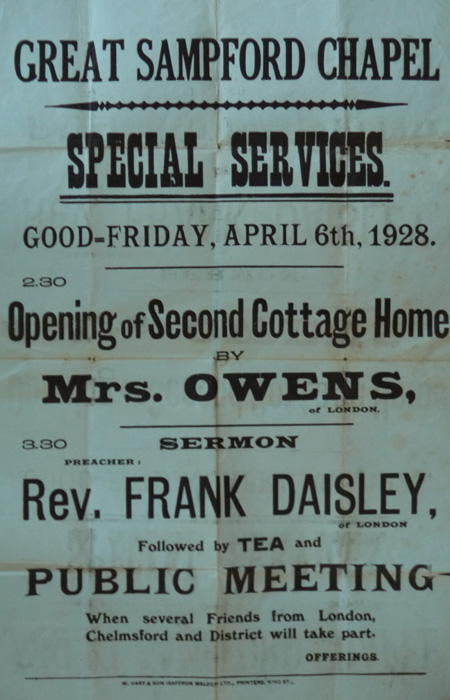
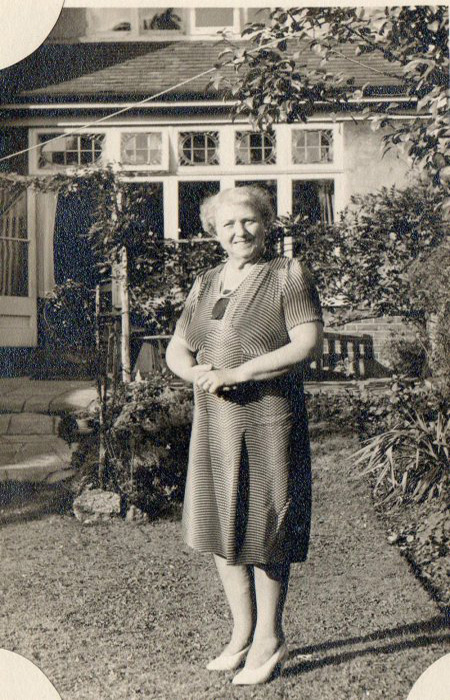
Forward to 1917AD

